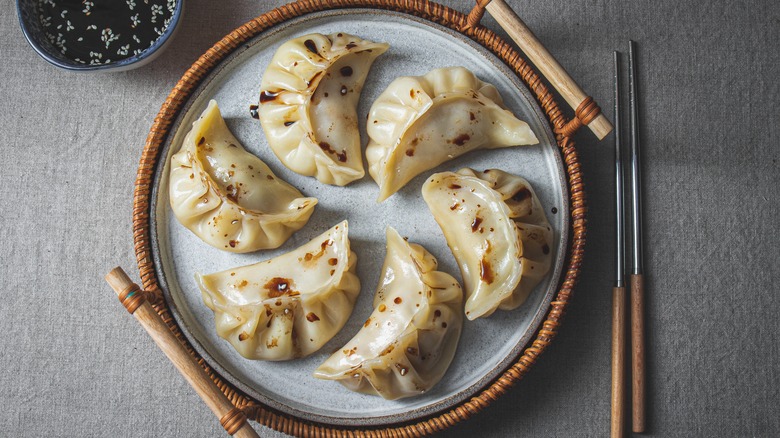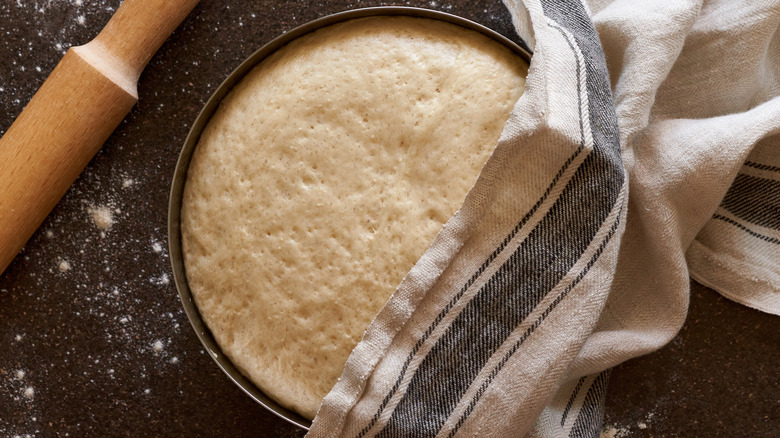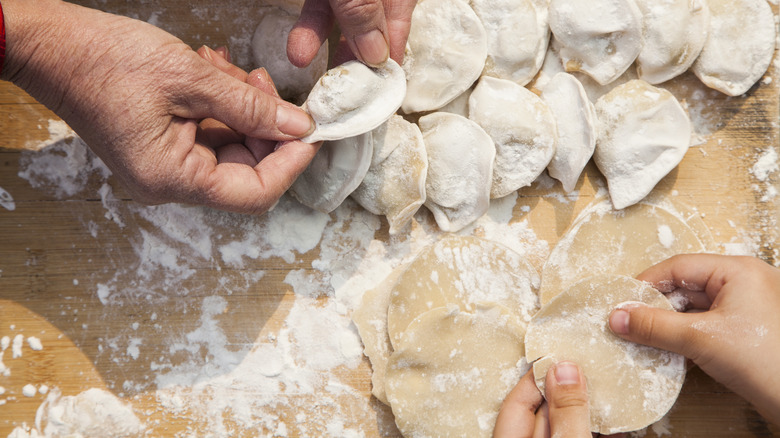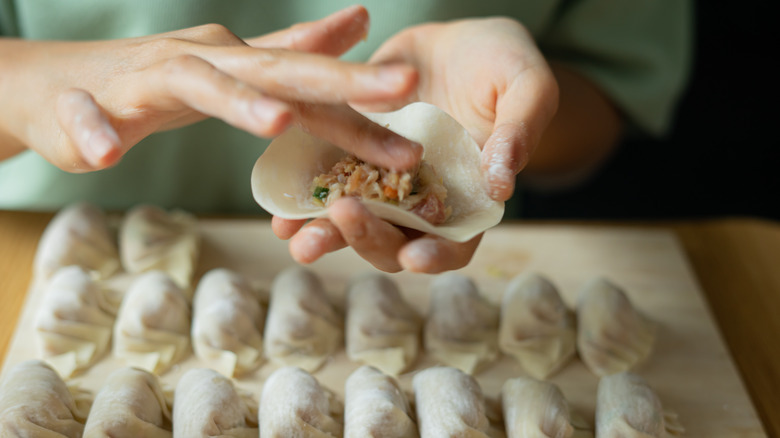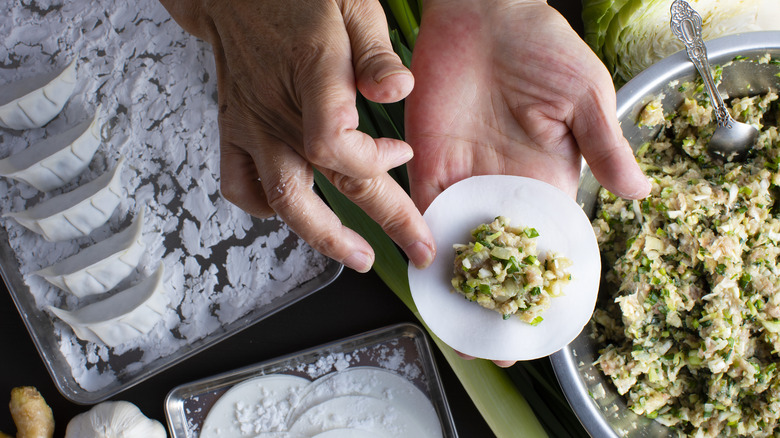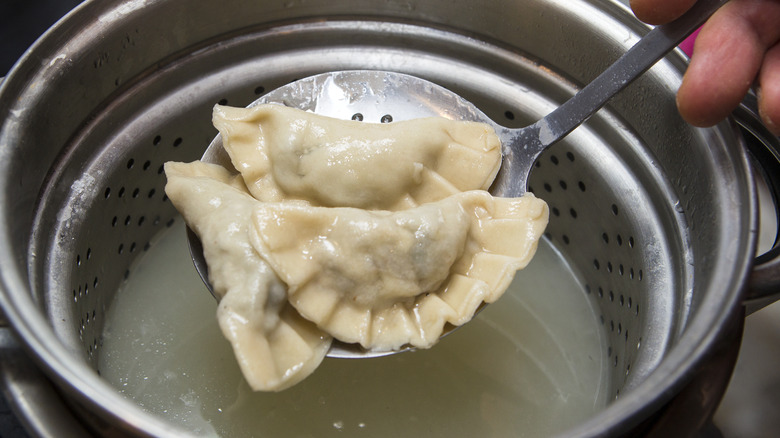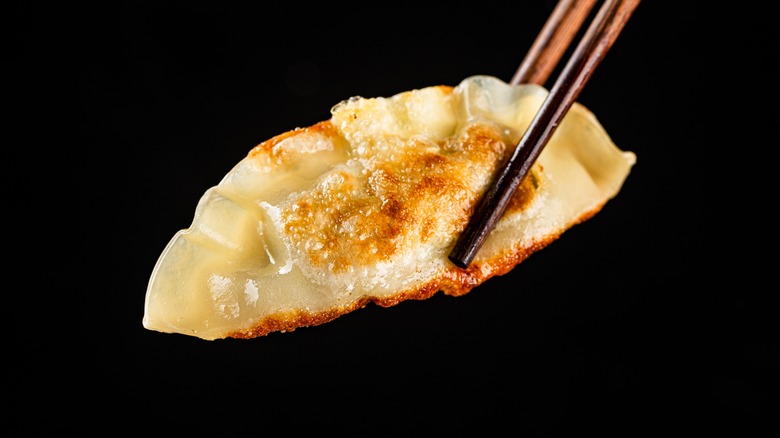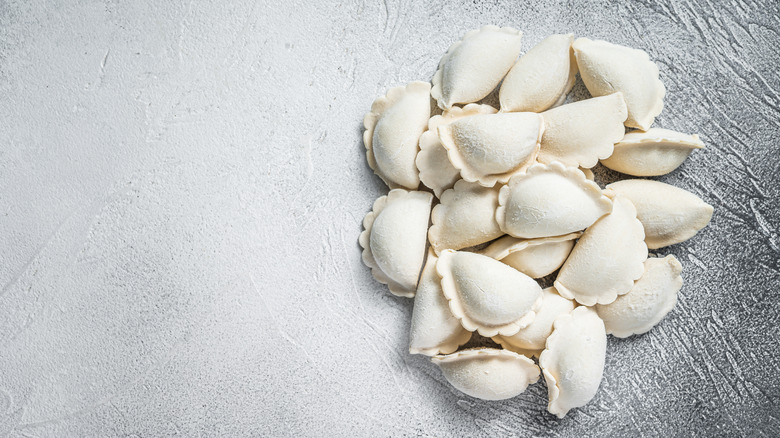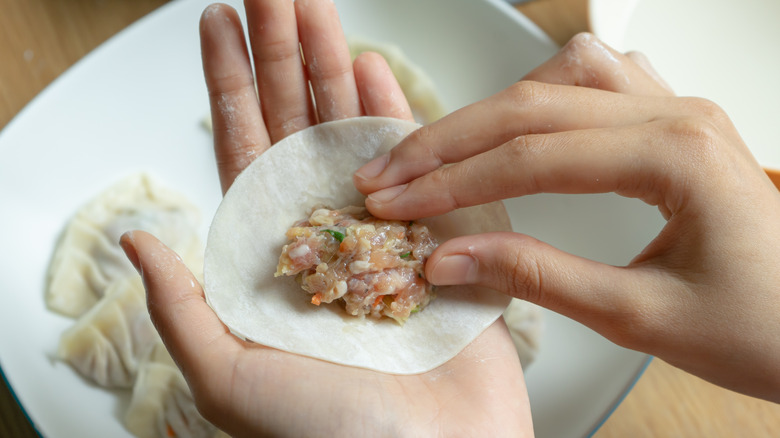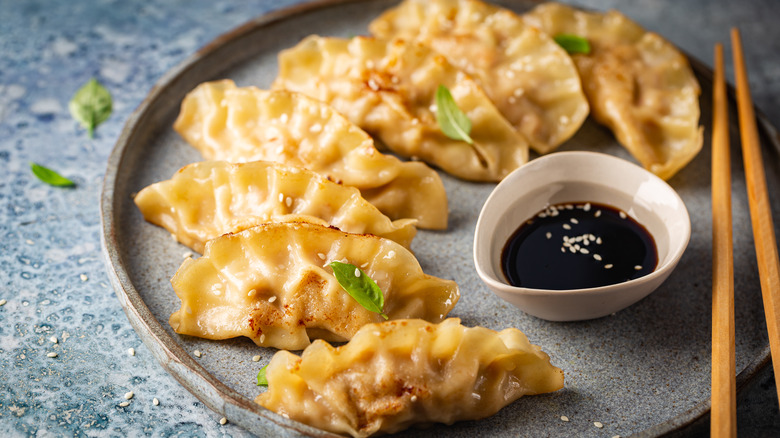14 Mistakes To Avoid When Making Dumplings
Few foods hit the spot like dumplings do. These perfect packages of filling wrapped in dough have been a core part of food cultures around the world for thousands of years. Dumplings are thought to have originated in China during the Han Dynasty and were allegedly originally created by one enterprising chef in small, ear-shaped pouches as a means to cure frostbite affecting the ears of villagers, making a food that's existed to this day.
Dumplings later sprang up in other parts of the world, with the Ancient Romans including a recipe for pheasant dumplings in "Apicius," one of the earliest-known cookbooks. Over the years, countries developed their own styles of dumplings, and nowadays, there's a dizzying variety out there. From manti, a meat dumpling popular in Turkey and other countries in Central and West Asia, to Polish pierogi, to Italian ravioli, it's hard to move for these little bites of deliciousness.
And while these days, frozen potstickers are readily available, there are few things more satisfying to make in the kitchen. But dumplings are far from easy to make. They're fiddly to construct, require several different components to be just right, and are easy to overcook. So how do you avoid some key mistakes when making and cooking your dumplings? Let us help you out.
1. You're using the wrong dough for your dumpling fillings
Not all dumpling doughs are made equal, and each dumpling has a slightly different formulation. In its most basic form, the dumpling dough is a combination of flour, water, and salt. This flour is generally wheat flour, and it's this dough that forms the wrapper for some of the most well-known dumplings out there, notably jiaozi and gyoza.
But adding different ingredients can give the dough different textures and flavors that may complement your fillings better. Take Chinese har gau, for instance. These dumplings are famed for their delicacy and tenderness, with a gently-flavored prawn filling. And the wrapper, therefore, needs to complement that, with chefs including tapioca starch in the recipe to give it a translucent white color and a slightly lighter taste.
On the other hand, Wontons benefit from having a slightly meatier wrapper, which holds up well in soup, so the dough is made with egg. Bao buns, well-known for their fluffy texture, have a dough that's slightly closer to a standard bread recipe, with yeast, baking powder, milk, and sugar.
And that's all before you get on to dumplings from around the world, like ravioli, which uses pasta dough. In short, the dumpling dough can be as simple or as complex as you'd like it to be, but it should match your filling and the style of your dumplings properly, or you won't get an authentic result.
2. You're not letting your dough rest
Making dough can be daunting if you've never done it before. But it can help to understand what's happening when you're putting it together. When you combine flour with water, the proteins in the dry product form a gluten network. It's this gluten that gives dough its stretchiness and chewiness, as well as what binds your dough ball together.
But if you mix the dough and then immediately get to work rolling it out, the gluten network in it will be overly tight and rigid. And this can lead to it being very difficult to shape into those small, super-thin wrappers that you need for dumplings and may give you an end result that's stiff and chewy.
Instead, once you've formed your ball of dough, give it a bit of time to rest before you begin to shape it, as this will allow it to soften and become pliable. While times may vary depending on the recipe you use and the ingredients in your dough, it's best to give it a minimum of 15 minutes at room temperature. Don't leave it for too long, though — if you let your dough rest for more than a few hours, it may become tough and hard to work with again.
3. Your dough isn't tailored to your cooking style
When we order dumplings in a restaurant, it can be easy to forget the amount of thought that goes into making each pretty little parcel. But those things take a lot of work – and cooking them takes even more. Dumplings can be cooked in a huge number of ways, from being steamed or boiled to being fried and deep-fried. And the cooking style needs to be paired with the consistency and thickness of the dough.
If you're making dumplings that are destined to be boiled, it's important to make each wrapped a little thicker. This will give it additional protection against the rolling boil of the water and stop the dumpling from falling apart or being penetrated. On the other hand, steamed dumplings can be made with a slightly thinner dough, which is well-suited to the gentle, consistent heat it's cooked in.
It's also worth bearing in mind that this may affect the size of your dumplings, with thicker wrappers generally being a little smaller in diameter and thin wrappers meant for steaming a bit larger. You should also make sure that the thickness of your wrapper matches the delicacy of your filling. If you have big, bulky things in your dumplings, it might be better to go for a thicker wrapper so that it contains everything properly.
4. You're overworking your filling
While some dumplings, like Italian gnocchi or British flour and suet dumplings, don't have fillings, others are crammed with meat and vegetables, giving them their moreish appeal. But getting your dumpling filling just right is a tricky business. One of the key mistakes people make is to overmix the filling they're making, hoping this will lead to a more incorporated flavor. While this may be the case, it will also lead to the ingredients becoming too bound together and sticky, and this can lead to heavy, dense dumplings.
Instead, remember that less is more. Dumpling fillings should only be mixed until they're just combined and then left alone. Remember that the flavors will meld together as the filling rests, so you don't need to beat it all together mercilessly. It's also useful to keep in mind that many dumpling fillings are full of delicate ingredients like green onions and ground meat. Ground meat, in particular, suffers heavily when overworked, as the fat can melt, diminishing its flavor and making it tough and crumbly.
5. You're leaving air in your dumplings
Filling dumplings is one of the most rewarding activities you can do in your kitchen, and it's a great activity to do with kids, too. But it's all too easy to get it wrong. One thing that people stumble upon repeatedly is exactly how much filling to put in each dumpling. Put too much in, and you'll end up not being able to seal your wrapper, leaving you either having to stretch it and make it too thin, or with meat and vegetables leaking out of the side. Put too little in, on the other hand, and you can either end up with a lump of mainly dough, or air in your dumpling.
And it's this air that you want to avoid. When you leave air pockets in a dumpling after sealing it, it can puff up when you cook it, leaving a gap between the meat and the wrapper. This leaves you with an unsatisfying bite as the wrapper then deflates and becomes loose around the filling. This is most noticeable when dumplings are steamed. Rather than have this happen, ensure that you press any excess air out of your dumpling before you seal it. And if in doubt, add a little more filling.
6. You're cooking your filling before putting it inside
If you're making meat dumplings, stuffing them without cooking the filling can initially feel somewhat frightening. After all, won't they just stay raw, and won't you have to overcook them to ensure they're safe? The answer is no.
While you should always read the recipe you're using carefully and cook the filling if it instructs you to, the majority of the time, fillings should remain uncooked until you steam or boil your dumplings. Simply mix them together, fill them, and cook. Dumplings, by their very nature, are small, and even a few minutes of cooking them in boiling water or steam will be enough to cook through the ground meat and finely-chopped vegetables inside. And if you cook the filling beforehand, you may end up with a filling that's overdone and dry.
That doesn't mean you have to guess what it's going to taste like, though. If you want to check the taste or seasoning levels of your dumpling filling before putting it in the wrappers, take a small piece of it and form it into a tiny patty, and fry it in a skillet. Once cooked, taste, and then adjust anything you need to before placing it in the dough.
7. You're folding them the same way every time
When you first come to make dumplings, the folding part can be difficult to master. But once you've mastered your first one, it can be all too tempting to stick with it. Remember, though, that different folds for dumplings can add serious visual appeal to your creations and make them all the more interesting to eat. Additionally, alternative dumpling folds can mix up the bite of your dumpling, giving you satisfying chewy bits to sink your teeth into. And learning different folds also allows you to differentiate between fillings if you're making more than one style.
For beginners, the half-moon shape is usually the easiest. You just place your filling in the center of your circular piece of dough and then fold it around the meat or vegetables. You can seal this with your hands or a fork. However, learning to make pleated edges by folding the thin ends over each other will seal it more effectively and make it look all the more impressive. If you have square wrappers, try making a pyramidal shape by folding each corner up on each other, forming a point at the top. Or, try folding it into a triangle and then curling the points around to meet each other to make a flower-bud shape.
8. You're steaming them wrong
Steaming dumplings is one of the most common ways to cook them and for good reason. Steaming is quick and simple, requires nothing more than water, a heat source, and a steaming vessel, and it's a fat-free, healthy method that produces a light result. But it can also be weirdly easy to get it wrong.
The steaming mistake you're probably making is not creating enough distance between your water and your steaming basket, either by using too much water or allowing your steamer to descend into it. This can leave your dumplings touching the water, thereby boiling them. Instead, it's best to use a minimal amount of water and place your steaming basket well above it.
Most bamboo or metal steamers are equipped to sit on top of a pot without getting wet and may have a ridged bottom to allow them to slot into a pot easily. There's no need to boil your water rapidly, either — once you've brought it to a simmer, allow it to remain at low heat, and the steam released will do the rest. Ensure that your steaming vessel has a secure lid so that the steam doesn't just escape.
9. You're overcooking your dumplings
Dumplings are dainty little things that may require slightly less cooking time than you think. And while it's vital to cook your dumplings for long enough to ensure any raw meat inside is cooked through, that may not take that long at all, depending on the method you choose.
If you're boiling your dumplings, you should cook them until they float to the top of the pot before adding a small amount of cold water and waiting for them to rise again. This will ensure they're fully cooked; the whole process should take roughly 8 minutes. Steaming dumplings may take a little bit longer, as it's a gentler heat source.
Try to aim for 10 minutes once your water has reached a consistent simmer. Pan-frying dumplings require about 4-5 minutes of steaming after you've crisped up the bottom. To check the doneness of a dumpling, take one and cut it through its thickest part — it's the best way to ensure that it's cooked all the way through. While it's not ideal to lose one of your dumplings before serving them, think of it this way: As the chef, you can then eat both halves, sampling them before anyone else does.
10. You're forgetting to fry them
If you've ordered dumplings in a Chinese restaurant before and have marveled at how they get them so chewy and yet crisp, it's likely they were fried. Pan-frying dumplings have some distinct advantages over other cooking methods. The first is the texture it gives a dumpling — taking a piece of food that could be soft and adding a crunchy, firm bottom to it is no easy feat. Frying dumplings also give them more visual appeal, and the oil gives them additional flavor and mouthfeel.
Unfortunately, when making dumplings at home, frying often gets forgotten, with people opting to take the simpler route of steaming or boiling — but it couldn't be easier. You just have to heat up some oil and place your dumplings in them, frying them until the bottom of them becomes crispy and golden brown. Then, pour some water over the dumplings. The water should reach the middle point of the dumplings — any more, and you'll end up boiling them fully.
Place a lid on, and allow them to cook for a few minutes. The water serves to steam the topside of the dumpling while also cooking the filling all the way through. Open the lid, allow the water to evaporate, and then serve.
11. You're defrosting your frozen dumplings
Frozen dumplings have a convenience that few other foods can replicate. But it can be tempting to defrost them, especially if your dumplings have raw meat or fish inside, to ensure that they cook through properly. It's important to remember that frozen dumplings are usually designed to be cooked straight from the freezer. And if you allow them to defrost, they may lose their shape, or you may end up overcooking them.
You can cook frozen dumplings pretty much any way you'd cook fresh ones, although it may be worth bearing in mind that some commercial dumpling wrappers can be super-thin, making them difficult to boil. And don't forget that you can also freeze homemade dumplings and cook them directly from frozen.
Cooking homemade dumplings straight from your freezer is recommended, as freezing and then defrosting them can create ice crystals that melt when they return to room temperature. This can leave your dumplings shapeless, and the dough can become too wet, with the filling losing its softness and becoming gritty.
To freeze your dumplings, it's best to place them on a baking sheet-lined pan and freeze them separately before placing them in a bag together. If you put them in a bag when raw, they'll end up sticking to each other as they freeze, making them impossible to separate.
12. You're throwing out your excess filling
If you've never made dumplings before, it can be very easy to overdo it on the filling and end up throwing it out. But in case you needed reminding, this is super wasteful. Roughly 40% of all of the food produced around the world ends up in the trash, for a total of 2.5 billion tons each year. And by throwing away your filling, you're not only contributing to the problem but also wasting money.
Just remember, you can reuse that filling. Dumpling fillings are usually pretty subtly-flavored and, as such, are able to slot into a load of different recipes. If you're making meat dumplings, one of the easiest things to do with leftover filling is to make meatballs out of them. You can then either fry these and eat them with pasta or rice or drop them straight into a soup for a quick and satisfying meal.
Meat fillings are also a great addition to fried rice and are able to crumble up well in a hot wok. This also works well for tofu or vegetable-based dumpling fillings. Just bear in mind that your filling will likely only last for a few days in the fridge before it starts to go off, so use it quickly.
13. You're only eating frozen dumplings as a side
Many people view dumplings as a side dish or as an addition to other meals like soups or stews. But the truth is that dumplings can be stars of the show in their own right. Frozen dumplings, in particular, can form the basis of a quick and easy meal, and in many situations, you can use them to replace rice or pasta.
Try cooking regular frozen dumplings in an Alfredo sauce, using them instead of pasta or gnocchi to make a robust meal. You can add anything you choose to this, from sliced vegetables to protein like bacon or pancetta — just make sure that the dumplings you're using aren't too strongly-flavored.
If you don't have any rice on hand, chop up some cooked dumplings and then fry them with meat and vegetables to make dumpling fried rice. Alternatively, steam or pan-fry some dumplings, and then use them as the base of your meal, before ladling over stir-fried meat or tofu, for a dumpling rice bowl — or air-fry some dumplings until crispy, and enjoy them with a spicy sauce for a meal all on their own.
14. You're forgetting the importance of sauce
The dough and filling are only half of the equation if you're cooking dumplings. These small morsels are nothing without sauce to serve them with. Dipping sauces are a standard part of the menu in Asian food cultures. Dumplings provide moisture and a sharp counterpoint to the gentler flavors of the fish.
The simplest sauces can be made using a combination of soy sauce and rice vinegar and will work with most dumplings. In a 50-50 ratio, this dipping sauce will give you an umami, savory flavor shot through with the sharpness of the vinegar, which will pair with pork and vegetable fillings excellently.
If you like something funkier, try using fish sauce, which adds a new savory layer to dipping sauces. For something slightly thicker, use a Thai sweet chili sauce, either on its own or mixed with other elements like chopped garlic or ginger. Thai sweet chili sauce works especially well with pan-fried or deep-fried dumplings, as the sauce's sharpness and sweetness help offset any heaviness from the fried dough.
